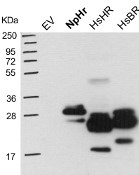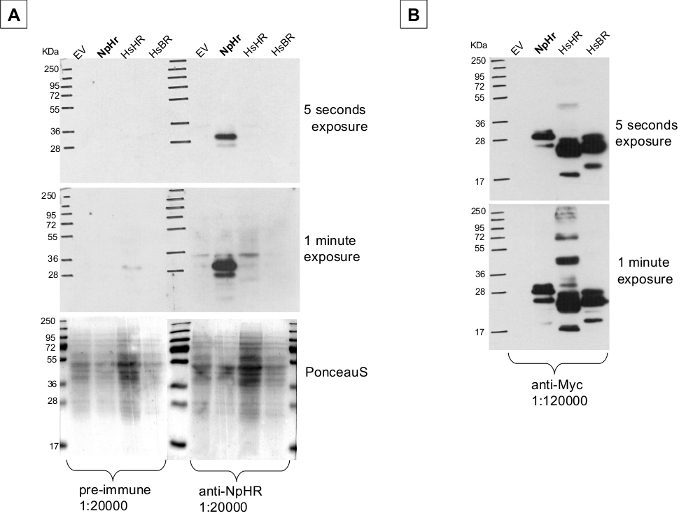1

Anti-NpHR | Halorhodopsin
AS12 1851 | Clonality: Polyclonal | Host: Rabbit | Reactivity: Natronomonas pharaonis
- Product Info
-
Immunogen: KLH-conjugated synthetic peptide derived from Natronomonas pharaonis halorhodopsin sequences UniProt: A0A1U7EU03
Host: Rabbit Clonality: Polyclonal Purity: Immunogen affinity purified serum in PBS pH 7.4. Format: Lyophilized Quantity: 50 µg Reconstitution: For reconstitution add 50 µl of sterile water Storage: Store lyophilized/reconstituted at -20°C; once reconstituted make aliquots to avoid repeated freeze-thaw cycles. Please remember to spin the tubes briefly prior to opening them to avoid any losses that might occur from material adhering to the cap or sides of the tube. Tested applications: Immunofluorescence (IF), Western blot (WB) Recommended dilution: 1 : 200 (IF), 1 : 1000 (WB) Expected | apparent MW: 30.9 | 30 kDa - Reactivity
-
Confirmed reactivity: Natronomonas pharaonis Predicted reactivity: Natronomonas pharaonis
Species of your interest not listed? Contact usNot reactive in: Halobacterium salinarum (HsHR and HsBR)
- Application Examples
-

Following SDS-PAGE (12% Seperation Gel) the Blot (PVDF) was stained with PonceauS (A, lowest panel), divided in two halves, scanned and blocked with 5 % not-fat milk powder (Marvel) o.n. at 4 °C. The halves were then incubated separately at RT for 1 h with anti-NpHR or pre-immune serum at the indicated dilutions, rinsed briefly twice with TBS-T (pH 7.4), then washed three times for 15 min, incubated for 1 h at RT with goat anti-rabbit-HRP conjugated secondary antibody (Agrisera, # AS09 602) in a dilution of 1:100 000 and washed as described before. The halves were combined for development with TMA-6 (Lumigen) at the indicated exposure times using Kodak X-ray Film (# 8143059)(A). The anti-NpHR blot was stripped at 70 °C for 30 min and re-probed with anti-Myc (Abcam, # ab9106) and anti-rabbit-HRP (Agrisera, # AS09 602, 1:200 000) as described below (B).
Samples loaded in the order as indicated above the blot were 9 μg (12 μg in case of HsHR; Amidoblack Assay) of total membrane fractions of yeast expressing: EV = empty vector control; NpHR = Halorhodopsin from Natronomonas pharaonis; HsHR = Halorhodopsin from Halobacterium salinarum; HsBR = Bacteriorhodopsin (D85T) from Halobacterium salinarum;NpHr, HsHR and HsBR include a C-terminal Myc tag. The calculated molecular weights are NpHR-Myc: 33.6 KDa; HsHR-Myc: 31.4 KDa; HsBR-Myc: 29.4 KDa.
Courtesy of Dr. Annegret Honsbein from Dr. Anna Amtmann's laboratory at the University of Glasgow, United Kingdom - Additional Information
-
Additional information (application): Immunofluorescence was performed on mouse brain slices (data not shown) - Background
-
Background: Halorhodopsin (HR) is a hyperpolarizing light-driven ion pump from the halophilic archaea bacterium Natronomonas pharaonis. HR uses the energy of yellow light (excitation maximum near 580 nm) to mediate primarily chloride but also bromide, iodide, and nitrate import into the cell against their electrochemical gradients.
- Product Citations
-
Selected references: Huang et al. (2024). Suppression of presynaptic corticostriatal glutamate activity attenuates L-dopa-induced dyskinesia in 6-OHDA-lesioned Parkinson's disease mice. Neurobiol Dis. 2024 Apr:193:106452. doi: 10.1016/j.nbd.2024.106452.
Alfonsa et al. (2015) The contribution of raised intraneuronal chloride to epileptic network activity. J Neurosci. 2015 May 20;35(20):7715-26. doi: 10.1523/JNEUROSCI.4105-14.2015. - Protocols
- Agrisera Western Blot protocol and video tutorials
- Reviews:
-
This product doesn't have any reviews.


